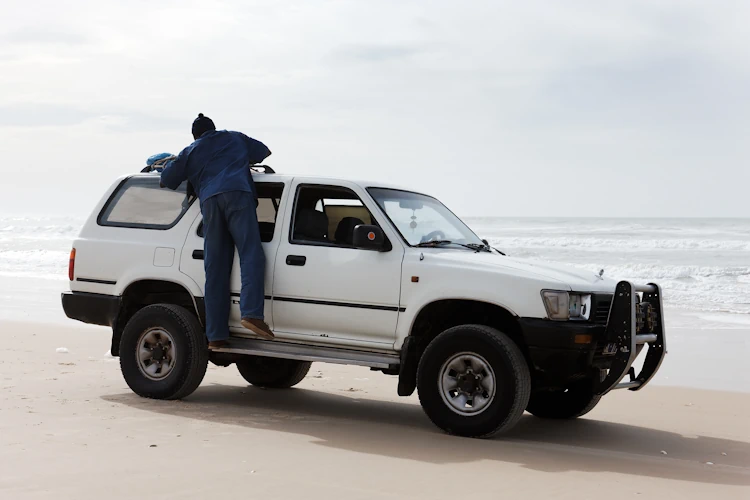Off-roading enthusiasts know that tackling rugged terrain comes with its fair share of challenges. From navigating rocky trails to traversing muddy paths, off-road adventures require vehicles that are equipped to handle the elements. While many enthusiasts focus on upgrades such as lift kits and oversized tires, there’s one essential accessory that often goes overlooked: the nudge bar. In this comprehensive guide, we explore why nudge bar are a must-have accessory for off-road enthusiasts, providing enhanced protection, improved off-road capability, and versatile utility.
Nudge bars, also known as bull bars or grille guards, are sturdy metal bars mounted to the front of vehicles. Originally designed to protect vehicles from collisions with animals in rural areas, nudge bars have become popular accessories among off-road enthusiasts for their ability to enhance vehicle protection and off-road capability. In this article, we delve into the various reasons why nudge bar are essential for off-road enthusiasts, from their enhanced protection to their versatility and utility.
Enhanced Protection
Impact Absorption
Nudge bars serve as the first line of defense for vehicles venturing into off-road terrain. Designed to absorb impact, nudge bars help minimize damage from collisions with obstacles such as rocks, branches, and debris. By deflecting potential impacts away from vital components such as the radiator and grille, nudge bars prevent costly damage and ensure that off-road adventures can continue without interruption.
Protection from Minor Collisions
In addition to providing protection from natural obstacles, nudge bars also safeguard vehicles from minor collisions with other vehicles or objects. Whether navigating narrow trails or maneuvering through tight spaces, the added protection of a nudge bar can prevent dents, scratches, and other cosmetic damage that may occur during off-road excursions.
Off-Road Capability
Improved Approach Angles
One of the key benefits of nudge bars is their ability to improve a vehicle’s approach angle—the angle at which it can safely approach obstacles without scraping the front bumper. By extending beyond the front grille, nudge bars create a protective barrier that allows vehicles to navigate steep inclines and uneven terrain with greater ease.
Protection of Vital Components
Off-road environments can be unforgiving, with rocks, branches, and other hazards posing a constant threat to vehicle components. Nudge bars help protect vital components such as the radiator, headlights, and grille from damage caused by impacts and debris, ensuring that the vehicle remains operational in the most challenging conditions.

Mounting Options and Compatibility
Bull Bar Compatibility
While nudge bars are often used interchangeably with bull bars, there are some key differences between the two. Bull bars typically offer more extensive coverage and protection than nudge bars, extending further back along the front of the vehicle. However, many nudge bars are designed to be compatible with bull bars, allowing off-road enthusiasts to customize their vehicles according to their specific needs and preferences.
Choosing the Right Nudge Bar
When selecting a nudge bar for off-road use, it’s essential to consider factors such as compatibility with the vehicle’s make and model, as well as the intended off-road terrain. Off-road enthusiasts should opt for nudge bars that are constructed from durable materials such as stainless steel or aluminum, with sturdy mounting brackets to withstand the rigors of off-road driving.
Material and Construction
Durability and Impact Resistance
The durability of a nudge bar is paramount when venturing off-road, where vehicles are subjected to constant jolts, bumps, and impacts. Stainless steel and aluminum are commonly used materials for nudge bar construction due to their strength and corrosion resistance. Additionally, nudge bars are often coated with protective finishes such as powder coating or chrome plating to enhance their durability and longevity.
Impact Absorption Mechanisms
In addition to their sturdy construction, many nudge bars incorporate innovative design features to enhance impact absorption. Some nudge bars feature integrated energy-absorbing mechanisms or shock mounts designed to dissipate energy and reduce the force of impacts, further protecting both the vehicle and its occupants during off-road excursions.
Installation Process
Step-by-Step Installation Guide
Installing a nudge bar requires careful planning and attention to detail to ensure proper fitment and alignment. While the specific installation process may vary depending on the make and model of the vehicle, the general steps typically include:
- Gather Necessary Tools: Before beginning the installation process, gather all the necessary tools and equipment, including wrenches, sockets, and mounting hardware.
- Prepare the Vehicle: Thoroughly clean the front end of the vehicle to remove any dirt, debris, or residue that may interfere with the installation process.
- Mount the Nudge Bar: Position the nudge bar in place and secure it to the vehicle’s frame using the provided mounting brackets and hardware.
- Adjust and Align: Once the nudge bar is mounted, adjust and align it as needed to ensure proper fitment and clearance.
- Securely Fasten: Double-check all mounting points to ensure that the nudge bar is securely fastened to the vehicle and will remain stable during off-road driving.
Versatility and Utility
Mounting Additional Accessories
In addition to providing protection and off-road capability, nudge bars offer versatility and utility by serving as mounting points for additional accessories. Off-road enthusiasts can customize their nudge bars with accessories such as LED light bars, winches, antennas, and recovery hooks, enhancing the functionality and aesthetics of their vehicles.
Practical Applications Beyond Off-Roading
While nudge bars are primarily associated with off-road use, their practical applications extend beyond rugged terrain. Nudge bars can be useful for mounting accessories such as roof racks, bike racks, and cargo carriers, making them valuable additions to vehicles used for camping, towing, or everyday driving.
Safety Considerations
Pedestrian Safety
When installing a nudge bar, it’s essential to consider pedestrian safety and ensure that the nudge bar does not obstruct the vehicle’s headlights or grille. Opt for nudge bars that are designed with pedestrian-friendly features such as rounded edges and integrated bull bar designs to minimize the risk of injury in the event of a collision.
Airbag Compatibility
Another critical safety consideration when installing a nudge bar is airbag compatibility. Ensure that the nudge bar does not interfere with the deployment of the vehicle’s airbags in the event of a collision. Consult the vehicle manufacturer’s guidelines and seek professional installation if necessary to ensure proper airbag function and passenger safety.
Cost and Value
Cost-Effectiveness
While the initial cost of purchasing and installing a nudge bar may seem significant, it’s essential to consider the long-term cost-effectiveness and value that nudge bars provide. By preventing costly damage from impacts and collisions, nudge bars can ultimately save off-road enthusiasts money on repair costs and vehicle maintenance in the long run.
Long-Term Value
In addition to their cost-effectiveness, nudge bars also offer long-term value by enhancing the resale and trade-in value of vehicles. Off-road enthusiasts are willing to pay a premium for vehicles equipped with nudge bars, making them a worthwhile investment for those looking to upgrade or sell their vehicles in the future.








